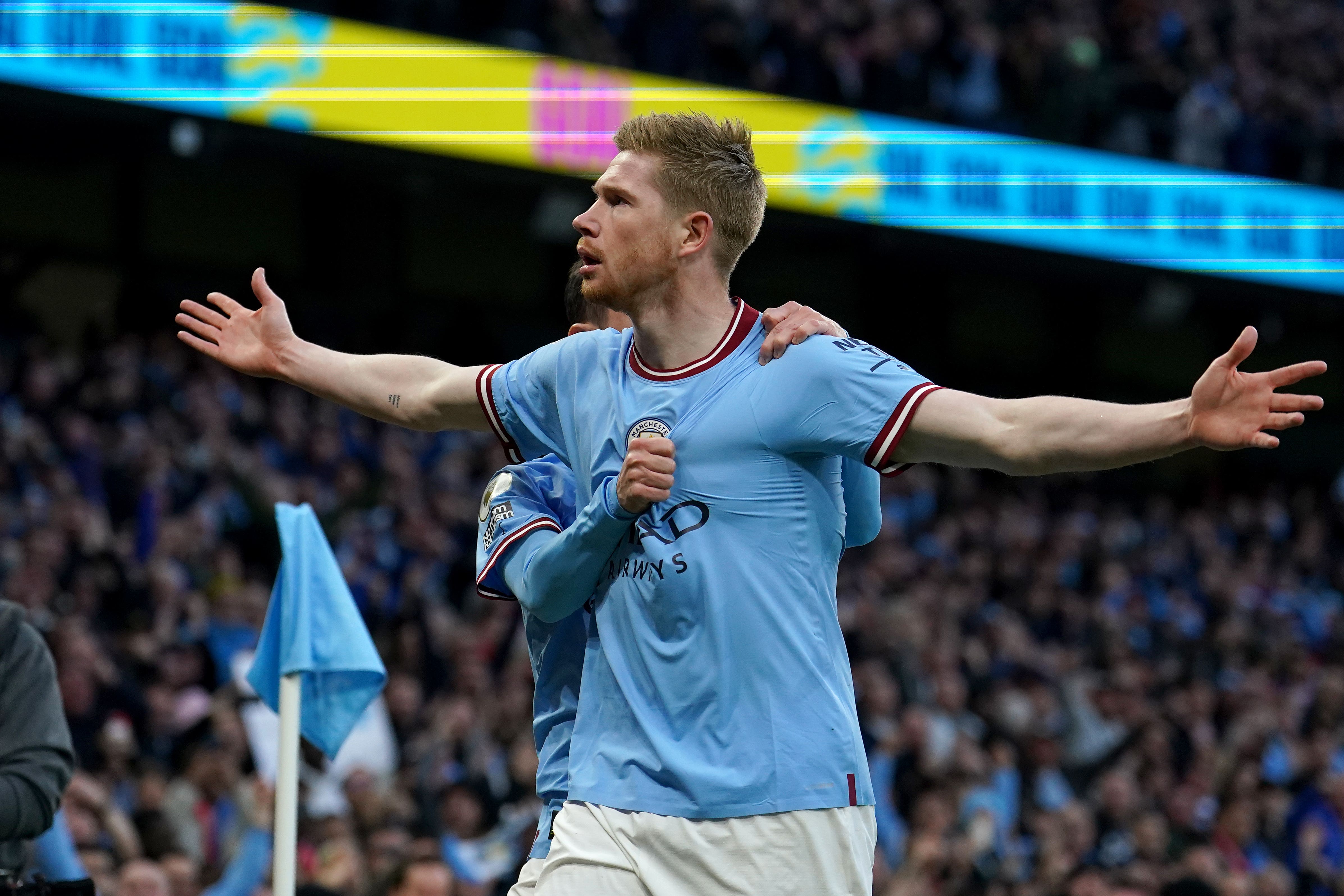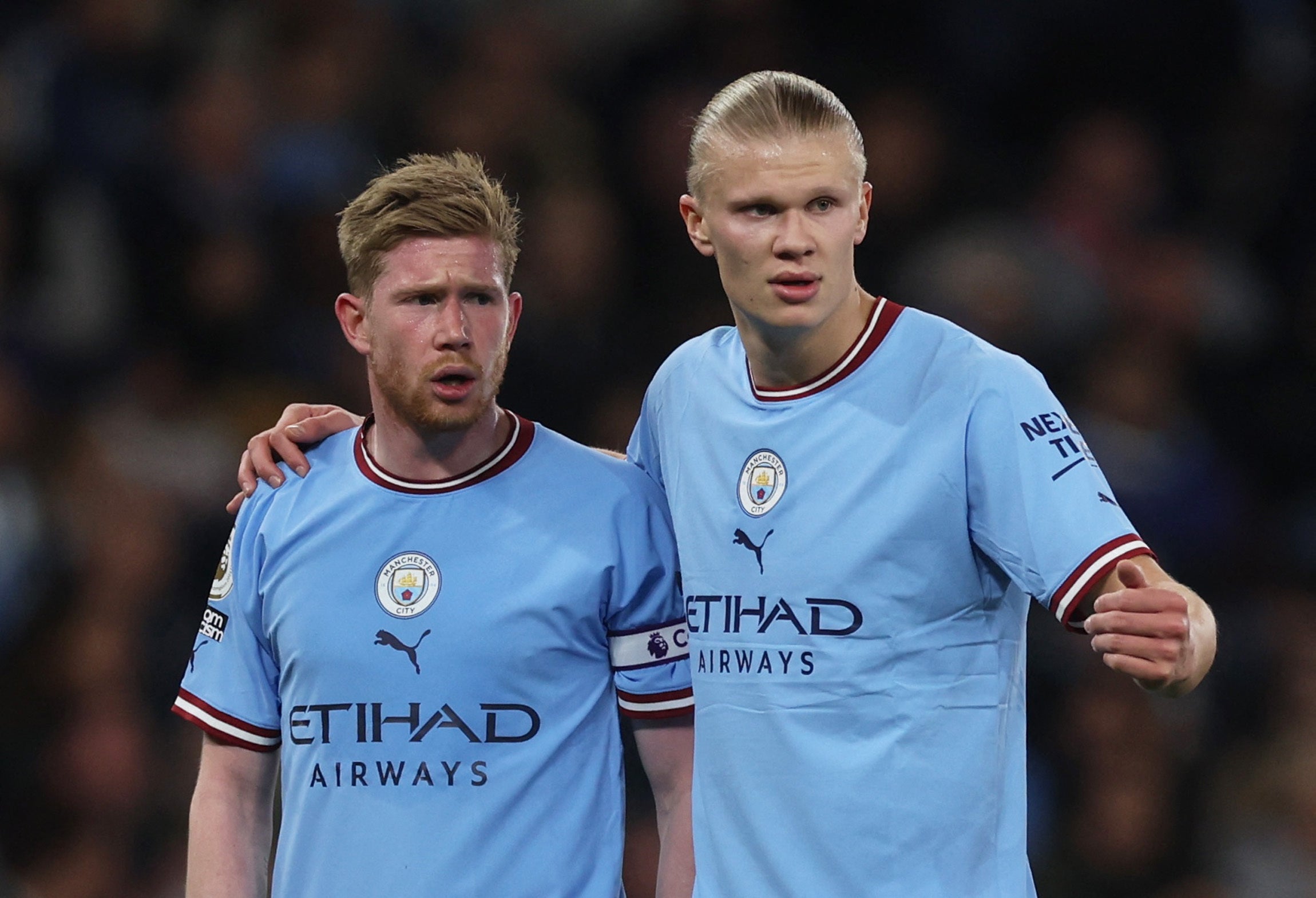Pep Guardiola unleashes Man City’s greatest threat – and it’s not Erling Haaland
Manchester City 4-1 Arsenal: Kevin De Bruyne scored twice as Pep Guardiola changed his system and Haaland turned provider to blow the Gunners apart

Your support helps us to tell the story
From reproductive rights to climate change to Big Tech, The Independent is on the ground when the story is developing. Whether it's investigating the financials of Elon Musk's pro-Trump PAC or producing our latest documentary, 'The A Word', which shines a light on the American women fighting for reproductive rights, we know how important it is to parse out the facts from the messaging.
At such a critical moment in US history, we need reporters on the ground. Your donation allows us to keep sending journalists to speak to both sides of the story.
The Independent is trusted by Americans across the entire political spectrum. And unlike many other quality news outlets, we choose not to lock Americans out of our reporting and analysis with paywalls. We believe quality journalism should be available to everyone, paid for by those who can afford it.
Your support makes all the difference.Pep Guardiola is the moderniser who revisits the past, the innovator who is proving nothing is new in football. He has borrowed the idea of the false nine from the Hungary sides of the 1950s and revived a 3-2-4-1 formation that was influenced by the W-M system. And, in seeking to retain the English title, he went more English than the prehistoric – or pre-Premier League – English.
The most significant goal in the division this season, the one to decisively tilt the balance Manchester City’s way, thus far came in a manner scarcely becoming of the mentor of Xavi and Andres Iniesta, the man who dreamed of a team of midfielders, the architect of tiki-taka. City bypassed the midfield. They aimed for the big man who, it transpired, had a good touch for a big man. They got a runner around him. They played a variant of 4-4-2.
It helped, of course, that the big man was Erling Haaland and the runner was Kevin De Bruyne. There is a school of thought that football is a simple game that can be overcomplicated by theorists and intellectuals like Guardiola, that the managers can assume a disproportionate importance. If, or perhaps when, City win the title it will in part be because they have the two finest footballers in the division, in Haaland and De Bruyne. Against their closest challengers, they put them in positions to do maximum damage. They wreaked havoc.
Arsenal were twice undone by a combination of the two. For the pivotal first, City went from back to front with remarkable speed, taking technicians like Ilkay Gundogan and Bernardo Silva out of the game. Haaland acted as the target man, taking down John Stones’ long ball. It may have stirred memories of Niall Quinn amid City fans of a certain vintage.
Haaland then released his sidekick. De Bruyne has a throwback feel; he belongs to a tradition of all-action figures who decide to determine games by force of personality and extreme talent. Put him in many a position and he can be reminiscent of Steven Gerrard. As a No 10, he has the power to burst forward, the dynamism to drive in shots. In an instant, this was the 2009 Gerrard.
Much like then, it was unleashing the outstanding midfielder in the country as an attacker. If the quintessential Guardiola midfielders are ill-suited to the centre-forward’s duties, De Bruyne flourished. He has been false nine and free eight in the past, deep-lying midfielder and right winger. Here he was half of a strike pair.
And Guardiola, long the scourge of the striker, in effect had two: one by trade, one by a bespoke plan. City’s shape could be 4-2-1-3; when it mattered, though, it was 4-4-2, with the two best players paired in attack, the other nine looking to get them the ball. It feels like a ploy from the playground, such is the basicness of the idea, an anti-Guardiola tactic.
Really, however, there was a devastating simplicity. City only needed two attackers: Arsenal were petrified of Haaland, unable to track, let alone stop De Bruyne. The only time Thomas Partey got near the Belgian, he could have conceded a penalty. The Norwegian was too big, too fast, too intimidating. It was an entirely legal form of bullying as Rob Holding lost his duel with Haaland. Aaron Ramsdale won his, sparing Arsenal a thrashing. The oddity was that Haaland and Holding finished with a goal apiece.

Haaland was the tormentor, De Bruyne the finisher. It was his role in the run-in last season when he was their top scorer. He has spent this year reinventing himself as Haaland’s supplier. Eight of the Norwegian’s 33 league goals were assisted by the Belgian. A role reversal or two followed. A pair of De Bruyne goals, a pair of Haaland assists, the second sidefooted in from a pass. It was a product of chemistry between a strike duo; in an instant, they were the Dwight Yorke and Andy Cole of the Etihad.
Their Manchester United team won three successive Premier Leagues. Guardiola’s City are set to emulate them. And if so, there is a case for arguing that it is De Bruyne’s title. The individual honours are surely bound for Haaland – 49 goals before the end of April can have that effect – but their league campaign may have come down to two games: both against Arsenal. City have got six points and seven goals. De Bruyne scored one and made one at the Emirates Stadium. He scored two and made the other at the Etihad, with his free kick headed in by Stones.
To deliver, one way or another, five goals over 180 minutes against the league leaders amounts to a colossal contribution. Amid the talk of history that Haaland’s scoring exploits have generated, the case grows for De Bruyne to be deemed the greatest player in City’s 143-year existence.


Join our commenting forum
Join thought-provoking conversations, follow other Independent readers and see their replies
Comments